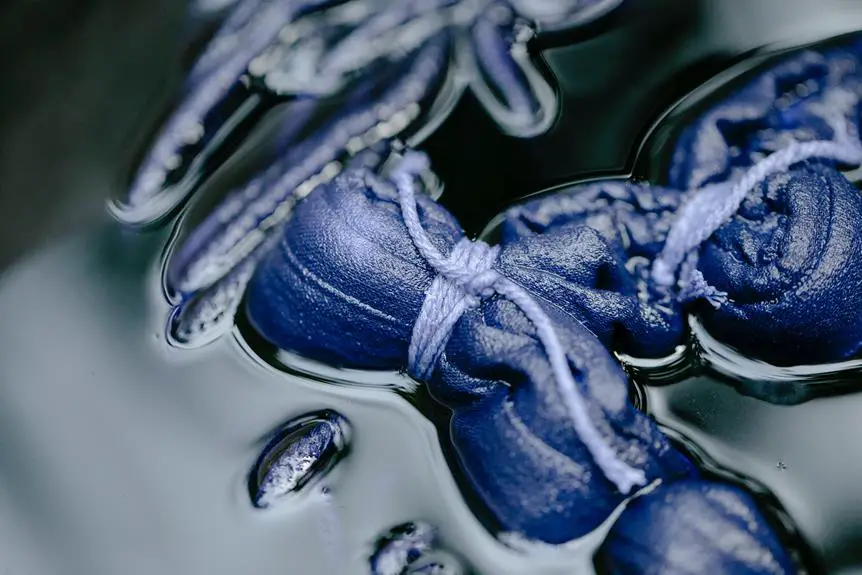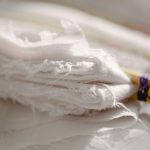If you're looking to elevate your fabric dyeing skills, these 5 unique reverse tie dye techniques will take your creations to the next level.
Each method offers a fresh approach to transforming fabric into stunning, one-of-a-kind pieces.
From the bleach reverse tie dye technique to the stenciled reverse tie dye method, ice dyeing, shibori-inspired reverse tie dye, and reverse tie dye with natural elements, you'll master a diverse range of innovative techniques to unleash your creativity.
Whether you're a seasoned fabric artist or just venturing into the world of reverse tie dye, these techniques will provide you with the expertise to craft truly exceptional designs.
Key Takeaways
- Bleach Reverse Tie Dye Techniques: Secure fabric with rubber bands, apply bleach mixture, monitor and rinse fabric
- Stenciled Reverse Tie Dye Techniques: Use stencils for sharp designs, experiment with color combinations, consider contrasts or gradients, select colors carefully
- Ice Dyeing Techniques: Lay fabric on rack, sprinkle ice, apply powdered dye, let fabric set for 24 hours before rinsing
- Shibori-Inspired Reverse Tie Dye Techniques: Use shibori-inspired resist techniques, apply indigo dye, create intricate patterns inspired by Japanese Shibori technique
Bleach Reverse Tie Dye Technique
To achieve the bleach reverse tie dye technique, start by laying the fabric flat and securing it with rubber bands where you want to create patterns. Next, prepare a mixture of bleach and water in a well-ventilated area. Carefully apply the bleach solution to the secured fabric using a spray bottle or sponge. The bleach application is crucial in creating unique patterns and designs. Remember to wear protective gloves and clothing to avoid direct contact with the bleach.
As the bleach sets in, you'll notice the color of the fabric starting to change. The duration for which the bleach is left on the fabric will determine the extent of color variation. Keep a close eye on the fabric as the bleach works its magic, and be prepared to stop the bleaching process at the desired color intensity. Once you've achieved the color variation you desire, rinse the fabric thoroughly to stop the bleaching action and remove any remaining bleach.
Mastering the bleach reverse tie dye technique requires precision in bleach application and attentiveness to color variation. With practice, you'll be able to create stunning and unique designs on your fabric.
Stenciled Reverse Tie Dye Method
Once you have mastered the bleach reverse tie dye technique, you can expand your repertoire by exploring the stenciled reverse tie dye method. This method allows you to incorporate intricate designs and precise patterns into your fabric creations, adding a new dimension to your tie dye projects. Stenciled patterns offer a level of detail and complexity that can elevate your fabric designs to a whole new level.
By using stencils, you can create sharp lines and intricate shapes that would be difficult to achieve with traditional tie dye methods.
When utilizing the stenciled reverse tie dye method, consider experimenting with creative color combinations to enhance the visual impact of your designs. Bold contrasts or subtle gradients can be employed to bring your stenciled patterns to life. Whether you opt for vibrant, eye-catching hues or a more muted, understated palette, the choice of colors can significantly influence the overall aesthetic of your fabric creations. By carefully selecting and applying colors, you can further customize your designs and make them uniquely yours.
With the stenciled reverse tie dye method, you have the opportunity to create fabric pieces that showcase your mastery of intricate patterns and creative color combinations.
Ice Dyeing for Fabric
You can achieve stunning and unique patterns on fabric with the ice dyeing method, creating a mesmerizing effect that complements the intricacy of stenciled reverse tie dye designs.
Ice dyeing is a form of fabric manipulation that involves utilizing color removal techniques to create one-of-a-kind designs. To begin, lay your presoaked fabric on a rack with a tray beneath it to catch the melting ice and dye.
Next, sprinkle the ice generously over the fabric, ensuring it covers the entire surface. Then, carefully apply your choice of powdered dye colors over the ice. As the ice melts, the dyes will seep through the fabric, blending and creating beautiful, organic patterns.
The gradual melting process allows for the colors to permeate the fabric, resulting in soft transitions and a watercolor-like effect. The fabric can then be left to set for an extended period, typically 24 hours, allowing the dye to fully penetrate the fibers.
Once set, rinse the fabric until the water runs clear, and admire your masterpiece. Ice dyeing is a captivating technique that offers endless possibilities for creating unique and visually striking fabric designs.
Shibori-Inspired Reverse Tie Dye
Achieving intricate and mesmerizing patterns on fabric, Shibori-inspired reverse tie dye builds upon the color removal techniques used in ice dyeing to create stunning and unique designs. Shibori is a Japanese manual resist dyeing technique that involves creating patterns by binding, stitching, folding, twisting, or compressing fabric. This method of fabric manipulation results in exquisite designs that are revealed through the indigo dyeing process.
To achieve Shibori-inspired reverse tie dye, you'll need to utilize shibori inspired resist techniques such as kanoko shibori (tie-dyeing), kumo shibori (twist-and-bind), and itajime shibori (shape-resist dyeing). These techniques allow you to create intricate patterns and designs on fabric by selectively preventing the dye from reaching certain areas.
Once the resist techniques are applied, the fabric is then subjected to the indigo dyeing process. The indigo dye, known for its deep and rich blue color, beautifully complements the intricate patterns created through the Shibori-inspired reverse tie dye techniques, resulting in stunning and visually captivating designs on fabric.
Reverse Tie Dye With Natural Elements
Utilize natural elements such as leaves, flowers, and roots to create unique reverse tie dye patterns on fabric. Natural dyeing techniques offer an eco-friendly approach to fabric design, allowing you to harness the beauty of nature while minimizing environmental impact. Here's how to elevate your fabric creations with natural elements:
- Foraged Foliage: Venture into the great outdoors and gather a variety of leaves and flowers with interesting shapes and textures. Experiment with different types of vegetation to discover the diverse patterns they can imprint on fabric.
- Root Power: Explore the world beneath your feet by using roots and barks to extract natural dyes. These earthy materials can yield a stunning range of colors, from rich browns to deep reds, adding a touch of organic warmth to your fabric designs.
- Eco-friendly Mordants: Embrace eco-friendly mordants such as alum, iron, and cream of tartar to enhance the colorfastness of natural dyes. These natural mordants not only fix the dye to the fabric but also contribute to sustainable dyeing practices.
- Sustainable Sourcing: Consider sourcing your natural dye materials from ethical and sustainable suppliers. By prioritizing eco-friendly practices, you can ensure that your creative process aligns with your values of environmental responsibility.
Frequently Asked Questions
Can I Use the Same Technique on Different Types of Fabric, Like Silk or Wool?
Yes, you can use the same reverse tie dye technique on different types of fabric, like silk or wool. Experimenting with silk dyeing and wool techniques will give you a range of unique and beautiful results.
How Can I Prevent the Bleach From Spreading Too Much and Ruining the Design?
To prevent the bleach from spreading and ruining your design, carefully apply it using a spray bottle or sponge. Protect your design by covering areas you don't want bleached with plastic or wax paper. Ensure fabric safety throughout the process.
Can I Use Regular Household Items as Stencils for the Stenciled Reverse Tie Dye Method?
Yes, you can use regular household items as stencils for the stenciled reverse tie dye method. Ensure fabric compatibility and experiment with various DIY designs. This approach adds creativity to your dyeing techniques.
Is There a Specific Type of Ice That Works Best for Ice Dyeing, or Can I Use Any Kind?
You can use any kind of ice for dyeing fabric, but larger, chunkier ice works best to create unique patterns. Experiment with different fabric types and ice sizes to achieve the best results in ice dyeing.
Are There Any Specific Natural Elements That Work Best for the Reverse Tie Dye With Natural Elements Technique, or Can I Use Any Plant or Herb?
You can use various natural elements for reverse tie dye, but some work better than others. Consider natural vs synthetic dyes and best practices for colorfastness. Experiment with different plant materials to find what works best for you.
- Kevlar Fabric in Dubai: Trends and Local Supplier Reviews - June 21, 2025
- Kevlar Dog Vest: Protecting Your Canine Companion - June 21, 2025
- Kevlar Dog Toys: Safe and Durable Pet Products - June 21, 2025






